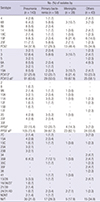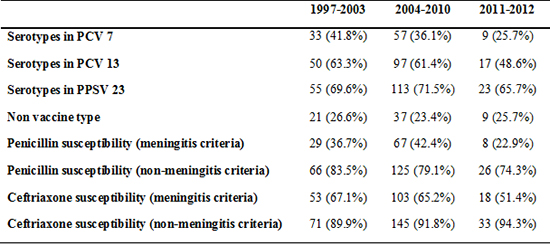1. Kwong JC, Crowcroft NS, Campitelli MA, Ratnasingham S, Daneman N, Deeks SL, Manuel DG. Ontario Burden of Infectious Disease Study. Toronto: Institute for Clinical Evaluative Sciences; Ontario Agency for Health Protection and Promotion;2010.
2. All Party Parliamentary Group for Child Health and Vaccine Preventable Diseases (GB). Improving Global Health by Preventing Pneumococcal Disease. London: All Party Parliamentary Group for Child Health and Vaccine Preventable Diseases;2008. p. 1–35.
3. Weinberger DM, Trzciński K, Lu YJ, Bogaert D, Brandes A, Galagan J, Anderson PW, Malley R, Lipsitch M. Pneumococcal capsular polysaccharide structure predicts serotype prevalence. PLoS Pathog. 2009; 5:e1000476.
4. Brueggemann AB, Griffiths DT, Meats E, Peto T, Crook DW, Spratt BG. Clonal relationships between invasive and carriage Streptococcus pneumoniae and serotype- and clone-specific differences in invasive disease potential. J Infect Dis. 2003; 187:1424–1432.
5. Henrichsen J. Six newly recognized types of Streptococcus pneumoniae. J Clin Microbiol. 1995; 33:2759–2762.
6. Harboe ZB, Benfield TL, Valentiner-Branth P, Hjuler T, Lambertsen L, Kaltoft M, Krogfelt K, Slotved HC, Christensen JJ, Konradsen HB. Temporal trends in invasive pneumococcal disease and pneumococcal serotypes over 7 decades. Clin Infect Dis. 2010; 50:329–337.
7. Navarro Torné A, Dias JG, Quinten C, Hruba F, Busana MC, Lopalco PL, Gauci AJ, Pastore-Celentano L. ECDC country experts for pneumococcal disease. European enhanced surveillance of invasive pneumococcal disease in 2010: data from 26 European countries in the post-heptavalent conjugate vaccine era. Vaccine. 2014; 32:3644–3650.
8. Rosen JB, Thomas AR, Lexau CA, Reingold A, Hadler JL, Harrison LH, Bennett NM, Schaffner W, Farley MM, Beall BW, et al. Geographic variation in invasive pneumococcal disease following pneumococcal conjugate vaccine introduction in the United States. Clin Infect Dis. 2011; 53:137–143.
9. Mendes RE, Costello AJ, Jacobs MR, Biek D, Critchley IA, Jones RN. Serotype distribution and antimicrobial susceptibility of USA Streptococcus pneumoniae isolates collected prior to and post introduction of 13-valent pneumococcal conjugate vaccine. Diagn Microbiol Infect Dis. 2014; 80:19–25.
10. Cho EY, Lee H, Choi EH, Kim YJ, Eun BW, Cho YK, Kim YK, Jo DS, Lee HS, Lee J, et al. Serotype distribution and antibiotic resistance of Streptococcus pneumoniae isolated from invasive infections after optional use of the 7-valent conjugate vaccine in Korea, 2006-2010. Diagn Microbiol Infect Dis. 2014; 78:481–486.
11. Dagan R, Melamed R, Muallem M, Piglansky L, Greenberg D, Abramson O, Mendelman PM, Bohidar N, Yagupsky P. Reduction of nasopharyngeal carriage of pneumococci during the second year of life by a heptavalent conjugate pneumococcal vaccine. J Infect Dis. 1996; 174:1271–1278.
12. Black S, Shinefield H, Fireman B, Lewis E, Ray P, Hansen JR, Elvin L, Ensor KM, Hackell J, Siber G, et al. Efficacy, safety and immunogenicity of heptavalent pneumococcal conjugate vaccine in children. Pediatr Infect Dis J. 2000; 19:187–195.
13. Song JY, Nahm MH, Moseley MA. Clinical implications of pneumococcal serotypes: invasive disease potential, clinical presentations, and antibiotic resistance. J Korean Med Sci. 2013; 28:4–15.
14. Clinical and Laboratory Standards Institute (US). Performance Standards for Antimicrobial Susceptibility Testing: Twenty-First Informational Supplement (M100-S21). Wayne, PA: Clinical and Laboratory Standards Institute;2011.
15. Kim ES, Shin JK, Oh HK. Elderly immunization program against invasive pneumococcal disease in Korea, 2013. Public Health Wkly Rep. 2013; 7:182–186.
16. Lim J, Eom CS, Kim S, Ke S, Cho B. Pneumococcal vaccination rate among elderly in South Korea. J Korean Geriatr Soc. 2010; 14:18–24.
17. Choe YJ, Yang JJ, Park SK, Choi EH, Lee HJ. Comparative estimation of coverage between national immunization program vaccines and non-NIP vaccines in Korea. J Korean Med Sci. 2013; 28:1283–1288.
18. Lee S, Bae S, Lee KJ, Yu JY, Kang Y. Changes in serotype prevalence and antimicrobial resistance among invasive Streptococcus pneumoniae isolates in Korea, 1996-2008. J Med Microbiol. 2013; 62:1204–1210.
19. Weinberger DM, Malley R, Lipsitch M. Serotype replacement in disease after pneumococcal vaccination. Lancet. 2011; 378:1962–1973.
20. Pilishvili T, Lexau C, Farley MM, Hadler J, Harrison LH, Bennett NM, Reingold A, Thomas A, Schaffner W, Craig AS, et al. Sustained reductions in invasive pneumococcal disease in the era of conjugate vaccine. J Infect Dis. 2010; 201:32–41.
21. Guevara M, Barricarte A, Gil-Setas A, García-Irure JJ, Beristain X, Torroba L, Petit A, Polo Vigas ME, Aguinaga A, Castilla J. Changing epidemiology of invasive pneumococcal disease following increased coverage with the heptavalent conjugate vaccine in Navarre, Spain. Clin Microbiol Infect. 2009; 15:1013–1019.
22. Fenoll A, Granizo JJ, Aguilar L, Giménez MJ, Aragoneses-Fenoll L, Hanquet G, Casal J, Tarragó D. Temporal trends of invasive Streptococcus pneumoniae serotypes and antimicrobial resistance patterns in Spain from 1979 to 2007. J Clin Microbiol. 2009; 47:1012–1020.
23. Elston JW, Santaniello-Newton A, Meigh JA, Harmer D, Allgar V, Allison T, Richardson G, Meigh R, Palmer SR, Barlow G. Increasing incidence of invasive pneumococcal disease and pneumonia despite improved vaccination uptake: surveillance in Hull and East Yorkshire, UK, 2002-2009. Epidemiol Infect. 2012; 140:1252–1266.
24. van Deursen AM, van Mens SP, Sanders EA, Vlaminckx BJ, de Melker HE, Schouls LM, de Greeff SC, van der Ende A; Invasive Pneumococcal Disease Sentinel Surveillance Laboratory Group. Invasive pneumococcal disease and 7-valent pneumococcal conjugate vaccine, the Netherlands. Emerg Infect Dis. 2012; 18:1729–1737.
25. Ihekweazu CA, Dance DA, Pebody R, George RC, Smith MD, Waight P, Christensen H, Cartwright KA, Stuart JM; South West Pneumococcus Study Group. Trends in incidence of pneumococcal disease before introduction of conjugate vaccine: South West England, 1996-2005. Epidemiol Infect. 2008; 136:1096–1102.
26. Cho EY, Kang HM, Lee J, Kang JH, Choi EH, Lee HJ. Changes in serotype distribution and antibiotic resistance of nasopharyngeal isolates of Streptococcus pneumoniae from children in Korea, after optional use of the 7-valent conjugate vaccine. J Korean Med Sci. 2012; 27:716–722.
27. Tin Tin Htar M, Christopoulou D, Schmitt HJ. Pneumococcal serotype evolution in Western Europe. BMC Infect Dis. 2015; 15:419.
28. van der Linden M, Falkenhorst G, Perniciaro S, Imöhl M. Effects of infant pneumococcal conjugate vaccination on serotype distribution in invasive pneumococcal disease among children and adults in Germany. PLoS One. 2015; 10:e0131494.
29. Lee SG. 2013 Korean National Immunization Survey. Seoul: Korea Centers for Disease Control and Prevention;2013.
30. Lee S, Lee K, Kang Y, Bae S. Prevalence of serotype and multidrug-resistance of Streptococcus pneumoniae respiratory tract isolates in 265 adults and 36 children in Korea, 2002-2005. Microb Drug Resist. 2010; 16:135–142.
31. Yasin RM, Zin NM, Hussin A, Nawi SH, Hanapiah SM, Wahab ZA, Raj G, Shafie N, Peng NP, Chu KK, et al. Current trend of pneumococcal serotypes distribution and antibiotic susceptibility pattern in Malaysian hospitals. Vaccine. 2011; 29:5688–5693.
32. Le CF, Palanisamy NK, Mohd Yusof MY, Sekaran SD. Capsular serotype and antibiotic resistance of Streptococcus pneumoniae isolates in Malaysia. PLoS One. 2011; 6:e19547.
33. Ho PL, Chiu SS, Ang I, Lau YL. Serotypes and antimicrobial susceptibilities of invasive Streptococcus pneumoniae before and after introduction of 7-valent pneumococcal conjugate vaccine, Hong Kong, 1995-2009. Vaccine. 2011; 29:3270–3275.
34. Hackel M, Lascols C, Bouchillon S, Hilton B, Morgenstern D, Purdy J. Serotype prevalence and antibiotic resistance in Streptococcus pneumoniae clinical isolates among global populations. Vaccine. 2013; 31:4881–4887.
35. Vila-Corcoles A, Ochoa-Gondar O, Gomez-Bertomeu F, Raga-Luria X; EPIVAC Study Group. Invasive pneumococcal disease in Catalonian elderly people, 2002-2009: serotype coverage for different anti-pneumococcal vaccine formulations at the beginning of the new conjugate vaccines era. Vaccine. 2011; 29:7430–7434.
36. Vickers I, Fitzgerald M, Murchan S, Cotter S, O’Flanagan D, Cafferkey M, Humphreys H. Serotype distribution of Streptococcus pneumoniae causing invasive disease in the Republic of Ireland. Epidemiol Infect. 2011; 139:783–790.
37. Jauneikaite E, Jefferies JM, Hibberd ML, Clarke SC. Prevalence of Streptococcus pneumoniae serotypes causing invasive and non-invasive disease in South East Asia: a review. Vaccine. 2012; 30:3503–3514.
38. Horácio AN, Diamantino-Miranda J, Aguiar SI, Ramirez M, Melo-Cristino J; Portuguese Group for Study of Streptococcal Infections. Serotype changes in adult invasive pneumococcal infections in Portugal did not reduce the high fraction of potentially vaccine preventable infections. Vaccine. 2012; 30:218–224.
39. Chiba N, Morozumi M, Sunaoshi K, Takahashi S, Takano M, Komori T, Sunakawa K, Ubukata K; IPD Surveillance Study Group. Serotype and antibiotic resistance of isolates from patients with invasive pneumococcal disease in Japan. Epidemiol Infect. 2010; 138:61–68.









 PDF
PDF ePub
ePub Citation
Citation Print
Print




 XML Download
XML Download